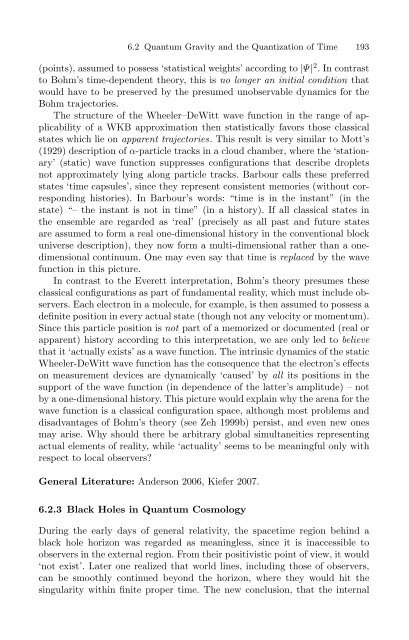The Physical Basis of The Direction of Time (The Frontiers ...
The Physical Basis of The Direction of Time (The Frontiers ...
The Physical Basis of The Direction of Time (The Frontiers ...
You also want an ePaper? Increase the reach of your titles
YUMPU automatically turns print PDFs into web optimized ePapers that Google loves.
6.2 Quantum Gravity and the Quantization <strong>of</strong> <strong>Time</strong> 193<br />
(points), assumed to possess ‘statistical weights’ according to |Ψ| 2 . In contrast<br />
to Bohm’s time-dependent theory, this is no longer an initial condition that<br />
would have to be preserved by the presumed unobservable dynamics for the<br />
Bohm trajectories.<br />
<strong>The</strong> structure <strong>of</strong> the Wheeler–DeWitt wave function in the range <strong>of</strong> applicability<br />
<strong>of</strong> a WKB approximation then statistically favors those classical<br />
states which lie on apparent trajectories. This result is very similar to Mott’s<br />
(1929) description <strong>of</strong> α-particle tracks in a cloud chamber, where the ‘stationary’<br />
(static) wave function suppresses configurations that describe droplets<br />
not approximately lying along particle tracks. Barbour calls these preferred<br />
states ‘time capsules’, since they represent consistent memories (without corresponding<br />
histories). In Barbour’s words: “time is in the instant” (in the<br />
state) “– the instant is not in time” (in a history). If all classical states in<br />
the ensemble are regarded as ‘real’ (precisely as all past and future states<br />
are assumed to form a real one-dimensional history in the conventional block<br />
universe description), they now form a multi-dimensional rather than a onedimensional<br />
continuum. One may even say that time is replaced by the wave<br />
function in this picture.<br />
In contrast to the Everett interpretation, Bohm’s theory presumes these<br />
classical configurations as part <strong>of</strong> fundamental reality, which must include observers.<br />
Each electron in a molecule, for example, is then assumed to possess a<br />
definite position in every actual state (though not any velocity or momentum).<br />
Since this particle position is not part <strong>of</strong> a memorized or documented (real or<br />
apparent) history according to this interpretation, we are only led to believe<br />
that it ‘actually exists’ as a wave function. <strong>The</strong> intrinsic dynamics <strong>of</strong> the static<br />
Wheeler-DeWitt wave function has the consequence that the electron’s effects<br />
on measurement devices are dynamically ‘caused’ by all its positions in the<br />
support <strong>of</strong> the wave function (in dependence <strong>of</strong> the latter’s amplitude) – not<br />
by a one-dimensional history. This picture would explain why the arena for the<br />
wave function is a classical configuration space, although most problems and<br />
disadvantages <strong>of</strong> Bohm’s theory (see Zeh 1999b) persist, and even new ones<br />
may arise. Why should there be arbitrary global simultaneities representing<br />
actual elements <strong>of</strong> reality, while ‘actuality’ seems to be meaningful only with<br />
respect to local observers?<br />
General Literature: Anderson 2006, Kiefer 2007.<br />
6.2.3 Black Holes in Quantum Cosmology<br />
During the early days <strong>of</strong> general relativity, the spacetime region behind a<br />
black hole horizon was regarded as meaningless, since it is inaccessible to<br />
observers in the external region. From their positivistic point <strong>of</strong> view, it would<br />
‘not exist’. Later one realized that world lines, including those <strong>of</strong> observers,<br />
can be smoothly continued beyond the horizon, where they would hit the<br />
singularity within finite proper time. <strong>The</strong> new conclusion, that the internal



![arXiv:1001.0993v1 [hep-ph] 6 Jan 2010](https://img.yumpu.com/51282177/1/190x245/arxiv10010993v1-hep-ph-6-jan-2010.jpg?quality=85)


![arXiv:1008.3907v2 [astro-ph.CO] 1 Nov 2011](https://img.yumpu.com/48909562/1/190x245/arxiv10083907v2-astro-phco-1-nov-2011.jpg?quality=85)








![arXiv:1002.4928v1 [gr-qc] 26 Feb 2010](https://img.yumpu.com/41209516/1/190x245/arxiv10024928v1-gr-qc-26-feb-2010.jpg?quality=85)
![arXiv:1206.2653v1 [astro-ph.CO] 12 Jun 2012](https://img.yumpu.com/39510078/1/190x245/arxiv12062653v1-astro-phco-12-jun-2012.jpg?quality=85)
